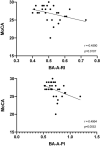Cerebral hemodynamic changes to transcranial Doppler sonography in celiac disease: A pilot study
- PMID: 36147295
- PMCID: PMC9487999
- DOI: 10.3389/fnhum.2022.931727
Cerebral hemodynamic changes to transcranial Doppler sonography in celiac disease: A pilot study
Abstract
Background: Sonographic mesenteric pattern in celiac disease (CD) suggests a hyperdynamic circulation. Despite the well-known CD-related neurological involvement, no study has systematically explored the cerebral hemodynamics to transcranial Doppler sonography.
Materials and methods: Montreal Cognitive Assessment (MoCA) and 17-item Hamilton Depression Rating Scale (HDRS) were assessed in 15 newly diagnosed subjects with CD and 15 age-, sex-, and education-matched healthy controls. Cerebral blood flow (CBF) velocities and indices of resistivity (RI) and pulsatility (PI) from the middle cerebral artery (MCA), bilaterally, and the basilar artery (BA) were recorded. We also assessed cerebral vasomotor reactivity (CVR) through the breath-holding test (BHT).
Results: Worse scores of MoCA and HDRS were found in patients compared to controls. Although patients showed higher values of CBF velocity from MCA bilaterally compared to controls, both at rest and after BHT, no comparison reached a statistical significance, whereas after BHT both RI and PI from BA were significantly higher in patients. A significant negative correlation between both indices from BA and MoCA score were also noted.
Conclusion: These treatment-naïve CD patients may show some subtle CVR changes in posterior circulation, thus possibly expanding the spectrum of pathomechanisms underlying neuroceliac disease and in particular gluten ataxia. Subclinical identification of cerebrovascular pathology in CD may help adequate prevention and early management of neurological involvement.
Keywords: celiac disease; cerebral blood flow; cerebral hemodynamics; cognition; depression; transcranial Doppler sonography; vasomotor reactivity.
Copyright © 2022 Fisicaro, Lanza, D’Agate, Pennisi, Cantone, Pennisi, Hadjivassiliou and Bella.
Conflict of interest statement
The authors declare that the research was conducted in the absence of any commercial or financial relationships that could be construed as a potential conflict of interest.
Figures
Similar articles
-
Transcranial Doppler sonography follow-up study in mild vascular cognitive impairment.PLoS One. 2025 Jan 24;20(1):e0317888. doi: 10.1371/journal.pone.0317888. eCollection 2025. PLoS One. 2025. PMID: 39854302 Free PMC article.
-
Cerebral Hemodynamic Changes to Transcranial Doppler in Asymptomatic Patients with Fabry's Disease.Brain Sci. 2020 Aug 12;10(8):546. doi: 10.3390/brainsci10080546. Brain Sci. 2020. PMID: 32806660 Free PMC article.
-
Flow velocity measurements as an index of cerebral blood flow. Validity of transcranial Doppler sonographic monitoring during cardiac surgery.Anesthesiology. 1994 Dec;81(6):1401-10. doi: 10.1097/00000542-199412000-00015. Anesthesiology. 1994. PMID: 7992909
-
Transcranial Doppler ultrasonography in neurological surgery and neurocritical care.Neurosurg Focus. 2019 Dec 1;47(6):E2. doi: 10.3171/2019.9.FOCUS19611. Neurosurg Focus. 2019. PMID: 31786564 Review.
-
Cerebral Blood Flow in Alzheimer's Disease: A Meta-Analysis on Transcranial Doppler Investigations.Geriatrics (Basel). 2024 May 4;9(3):58. doi: 10.3390/geriatrics9030058. Geriatrics (Basel). 2024. PMID: 38804315 Free PMC article. Review.
Cited by
-
Challenging the Pleiotropic Effects of Repetitive Transcranial Magnetic Stimulation in Geriatric Depression: A Multimodal Case Series Study.Biomedicines. 2023 Mar 21;11(3):958. doi: 10.3390/biomedicines11030958. Biomedicines. 2023. PMID: 36979937 Free PMC article.
-
Celiac Disease and Neurological Manifestations: From Gluten to Neuroinflammation.Int J Mol Sci. 2022 Dec 8;23(24):15564. doi: 10.3390/ijms232415564. Int J Mol Sci. 2022. PMID: 36555205 Free PMC article. Review.
-
Transcranial Doppler sonography follow-up study in mild vascular cognitive impairment.PLoS One. 2025 Jan 24;20(1):e0317888. doi: 10.1371/journal.pone.0317888. eCollection 2025. PLoS One. 2025. PMID: 39854302 Free PMC article.
References
LinkOut - more resources
Full Text Sources
Research Materials
Miscellaneous


